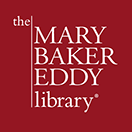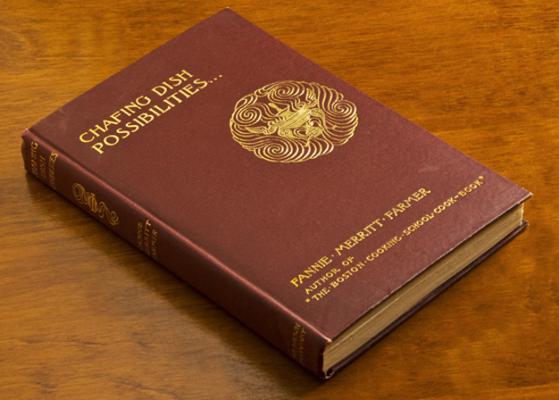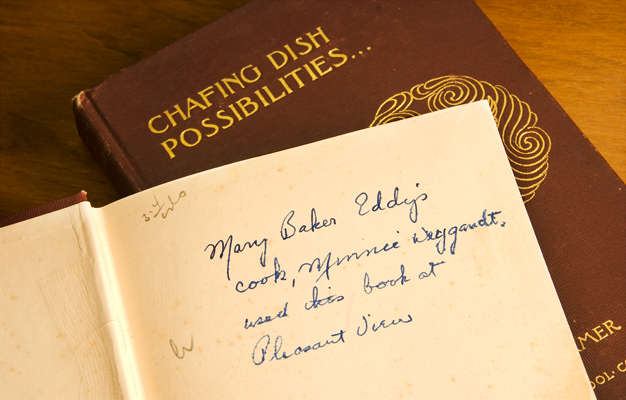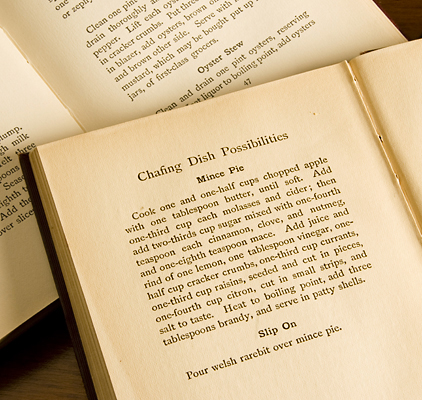The cover of the Chafing Dish Possibilities used in Mary Baker Eddy’s home at Pleasant View.
Many of us enjoy sharing good food with family and friends, and Mary Baker Eddy was no different. As Eddy’s cook from 1899-1907, Minnie Weygandt stated in her reminiscences she kept lists of the meals she cooked in the house and kept track of favorite recipes. The Library has in its collections some of the books that Weygandt selected recipes from, including two copies of Chafing Dish Possibilities by Fannie Merritt Farmer, in the rare book collection in Lending and Reference Services.
Farmer (1857-1915) was born to a poor family in Boston. At 16, she could not continue her education because of paralysis in her leg, which prevented her from walking. As her health improved, she became a mother’s helper for a family friend, Mrs. Charles Shaw. Shaw encouraged Farmer to cook, and when the youngest Shaw daughter asked one day what all the instructions, such as “pinch” or “handful” meant, Farmer found her calling.
Many years later, both her own family and Shaw urged her to enroll at the Boston Cooking School, which she did in 1887. According to “Not by Bread Alone: America’s Culinary Heritage” online digital archive, the school was founded in 1879 by Mary J. Lincoln. The school sought to train women to become professional cooks in homes, or to prepare them to teach cooking in schools. Farmer completed the two-year course and then stayed on as assistant principal. By 1894, she was the head of the school. In 1902, she resigned that position to start her own school, Miss Farmer’s School of Cookery, which put a stronger emphasis on teaching housewives a novel concept: using standards in home cooking.
A century ago, cookbooks were very different from the books we see in stores today. “Not by Bread Alone” describes them as having almost no step-by-step instruction, with no quantities of ingredients and ambiguous directions. It was into this world that Farmer’s well-known The Boston Cooking School Cook-Book was first published in 1896. Her publisher felt it was such a risky venture that she was required to pay the publishing costs herself. But the book was a great success and was considered innovative, with its clear recipes and complete timing and preparation instructions.
This first book was followed by several others, including Chafing Dish Possibilities in 1898. A chafing dish is a kind of portable, raised dish, originally heated with charcoal in a brazier. This type of dish was often used for foods that required gentle, indirect cooking. It could also be used at a table or could be put on a buffet with a cover to keep food warm. The dish was something handy to have in a household that served many people, like Eddy’s Pleasant View home in Concord, N.H.
Of the Library’s two copies, one contains a note on one of the end pages. The note explains that Weygandt owned a copy of Chafing Dish Possibilities and used it at Pleasant View to prepare suppers. Regardless, Farmer’s influence was to be felt by those in Eddy’s household. Weygandt wrote in her reminiscence of working for Eddy:
“In order to learn all the newest and best ways of cooking I had brought all my cookbooks with me and subscribed to the Boston Cooking School magazine. As soon as the magazine came I went through it to see if there was anything new I thought Mrs. Eddy would like.”1
Weygandt also described some of the meals she prepared for Eddy, noting oyster stew was one of her favorite dishes to serve to company. Could Farmer’s oyster stew recipe from Chafing Dish Possibilities be the one that Weygandt served? Other recipes that, according to Weygandt, appeared on Eddy’s table and are in Farmer’s book include mince pie and a variety of homemade candies.




